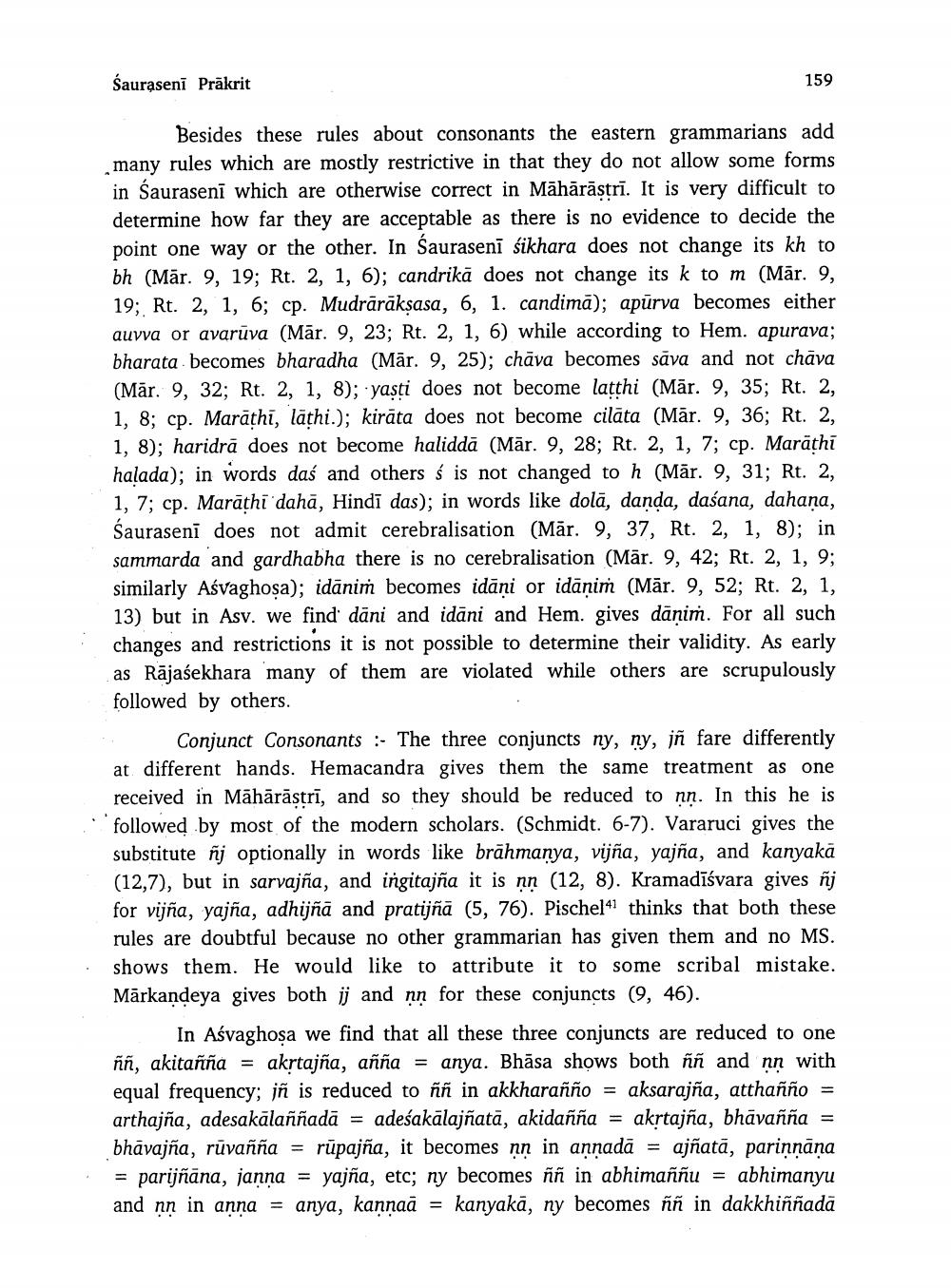________________
Sauraseni Prākrit
159
Besides these rules about consonants the eastern grammarians add many rules which are mostly restrictive in that they do not allow some forms in Saurasenī which are otherwise correct in Māhārāstrī. It is very difficult to determine how far they are acceptable as there is no evidence to decide the point one way or the other. In Saurasenī śikhara does not change its kh to bh (Mār. 9, 19; Rt. 2, 1, 6); candrikā does not change its k to m (Mār. 9, 19; Rt. 2, 1, 6; cp. Mudrārāksasa, 6, 1. candimā); apūrva becomes either auvva or avarūva (Mār. 9, 23; Rt. 2, 1, 6) while according to Hem. apurava; bharata becomes bharadha (Mār. 9, 25); chāva becomes sāva and not chāva (Mār. 9, 32; Rt. 2, 1, 8); yasti does not become latthi (Mār. 9, 35; Rt. 2, 1, 8; cp. Marathi, lāthi.); kirāta does not become cilāta (Mār. 9, 36; Rt. 2, 1, 8); haridrā does not become haliddā (Mār. 9, 28; Rt. 2, 1, 7; cp. Marathi halada); in words das and others Ś is not changed to h (Mār. 9, 31; Rt. 2, 1, 7; cp. Marathi dahā, Hindi das); in words like dolā, danda, daśana, dahana, Sauraseni does not admit cerebralisation (Mār. 9, 37, Rt. 2, 1, 8); in sammarda and gardhabha there is no cerebralisation (Mār. 9, 42; Rt. 2, 1, 9; similarly Aśvaghoṣa); idānim becomes idāņi or idāņiṁ (Mār. 9, 52; Rt. 2, 1, 13) but in Asv. we find dāni and idāni and Hem. gives dāņim. For all such changes and restrictions it is not possible to determine their validity. As early as Rājasekhara many of them are violated while others are scrupulously followed by others.
Conjunct Consonants : The three conjuncts ny, ny, jñ fare differently at different hands. Hemacandra gives them the same treatment as one received in Māhārāstrī, and so they should be reduced to nn. In this he is followed by most of the modern scholars. (Schmidt. 6-7). Vararuci gives the substitute ñj optionally in words like brāhmanya, vijña, yajña, and kanyakā (12,7), but in sarvajña, and ingitajña it is nn (12, 8). Kramadīśvara gives ñj for vijña, yajña, adhijñā and pratijñā (5, 76). Pischel41 thinks that both these rules are doubtful because no other grammarian has given them and no MS. shows them. He would like to attribute it to some scribal mistake. Mārkandeya gives both jj and nn for these conjuncts (9, 46).
In Aśvaghosa we find that all these three conjuncts are reduced to one ññ, akitañña = akrtajña, añña = anya. Bhāsa shows both ññ and nn with equal frequency; jñ is reduced to ññ in akkharañño = aksarajña, atthañño = arthajña, adesakālaññadā = adeśakālajñatā, akidañña = akrtajña, bhāvañña = bhāvajña, rūvañña = rūpajña, it becomes nn in annadā = ajñatā, parinnāna = parijñāna, janna = yajña, etc; ny becomes ññ in abhimaññu = abhimanyu and nn in anna = anya, kannaa = kanyakā, ny becomes ññ in dakkhiññadā




